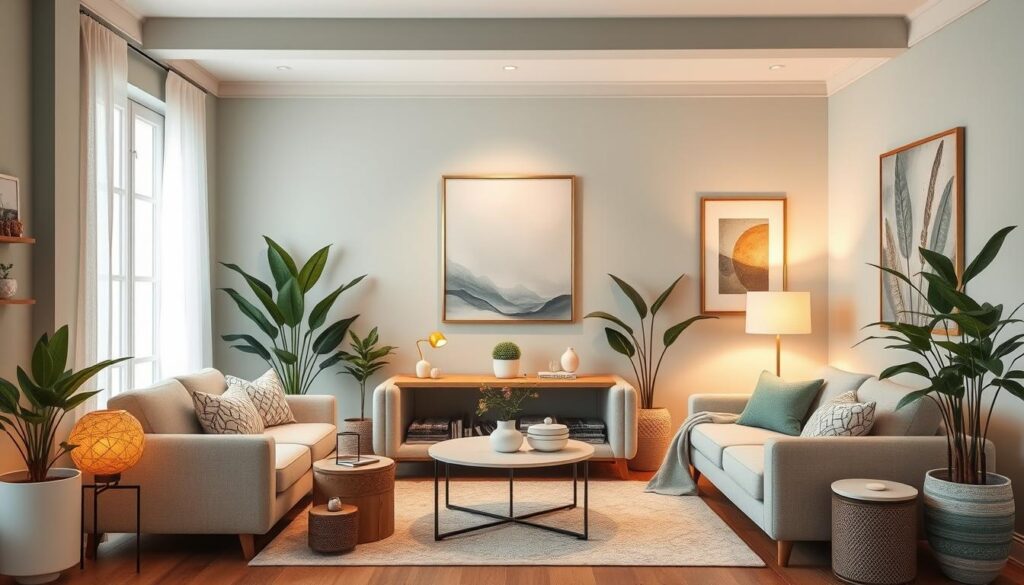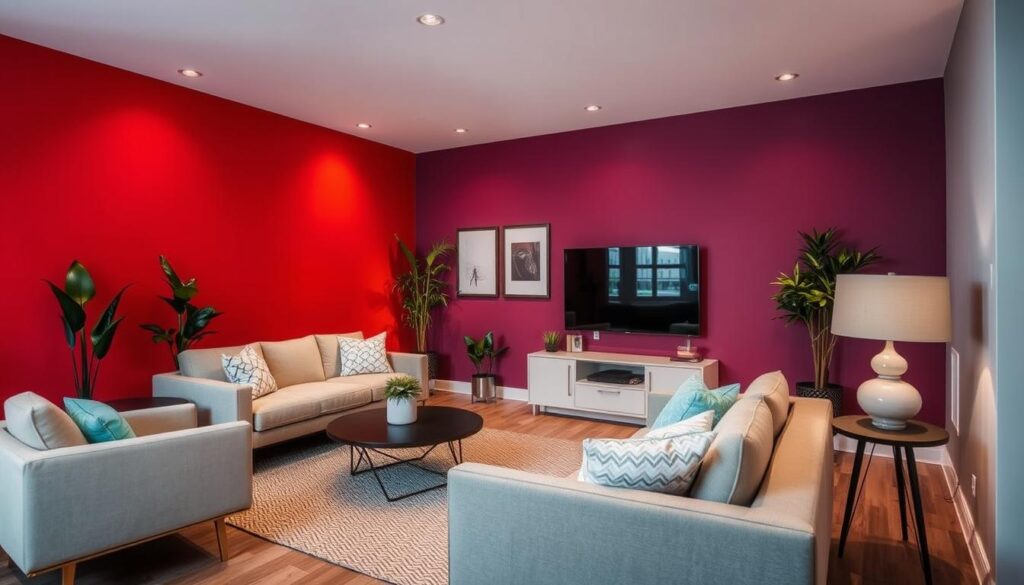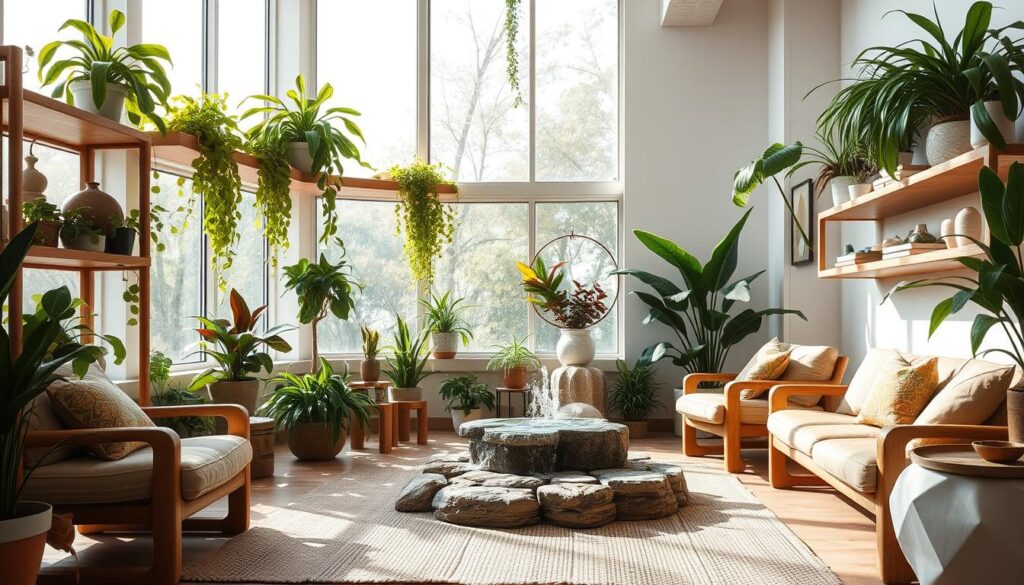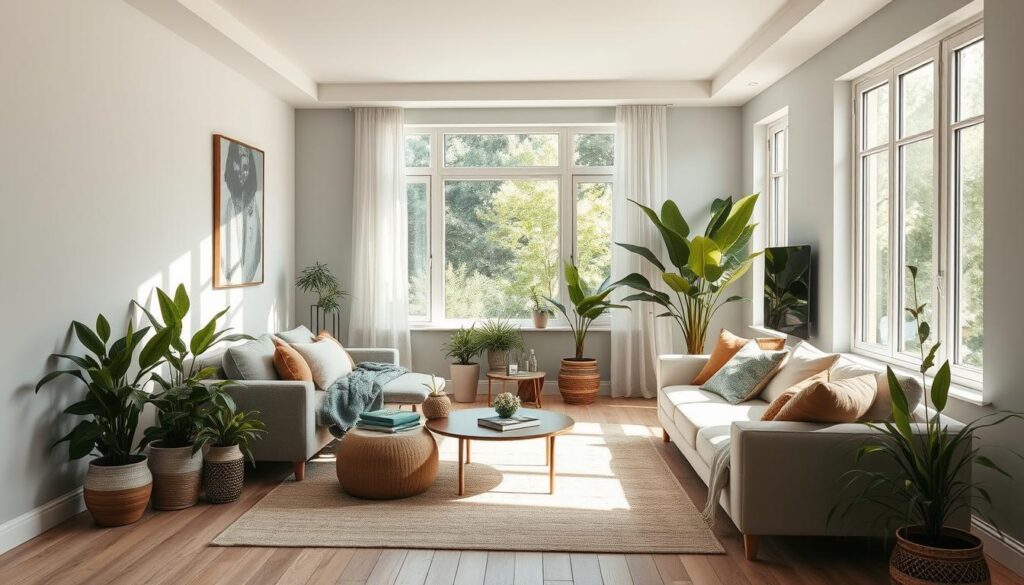Colors around us deeply affect our feelings, energy, and health. In our homes, choosing the right colors can change the mood and make a cozy space just for us. This article explores how color can change our mood, using color psychology and design tips.
Key Takeaways
- Colors have the ability to shape the mood and atmosphere of a living space
- Understanding color psychology is crucial for creating desired emotional responses
- Strategically selecting color schemes can enhance the overall harmony and ambiance of a home
- Accent walls and biophilic design can be powerful tools for mood enhancement
- Lighting and paint techniques play a significant role in amplifying the emotional impact of color
The Power of Color in Creating Mood in Your Home
Choosing the right colors is key to setting the mood in your home. Color and emotion work together to make a space feel alive or calm. Warm colors like reds and oranges can energize a room. On the other hand, cool colors like blues and greens can make you feel relaxed.
Biophilic design uses nature-inspired colors to bring peace and happiness. Think of soft blues and greens, like clear skies and green forests, filling your home. These colors can make your living spaces feel calm and welcoming.
Lighting also plays a big role in setting the mood. The right light can add depth and energy to a room. It’s all about the color harmonies you choose to highlight.
| Color Family | Emotional Impact | Recommended Spaces |
|---|---|---|
| Warm Colors (Red, Orange, Yellow) | Energizing, Stimulating | Home Offices, Dining Rooms |
| Cool Colors (Blue, Green, Purple) | Calming, Serene | Bedrooms, Bathrooms |
Knowing how colors affect us can help you create the perfect mood in each room. This way, you can make your home a place of harmony and joy.
Understanding Color Psychology
Exploring color psychology, we see how colors affect our feelings and the mood of our homes. Warm colors like reds bring energy, while cool blues calm us down. Knowing color theory helps us create spaces that feel right.
Warm vs. Cool Colors
Colors fall into two main groups: warm and cool. Warm colors, like reds and oranges, make us feel energetic and excited. They make spaces feel cozy and welcoming. Cool colors, such as blues and greens, bring calm and peace. They’re perfect for places where you want to relax.
Color Associations and Meanings
Each color has its own special meanings. Red is often seen as love and energy, while blue is about trust and calmness. Knowing these meanings lets you choose colors that match the mood you want in your home.
| Color | Associations and Meanings |
|---|---|
| Red | Love, passion, energy, aggression |
| Blue | Calmness, trust, intelligence, stability |
| Green | Nature, growth, harmony, freshness |
| Yellow | Happiness, optimism, creativity, warmth |
| Purple | Royalty, luxury, creativity, spirituality |
Understanding color psychology helps you pick the right colors for your home. This way, each room can have the mood you want, improving your well-being.

“Colors, like features, follow the changes of the emotions.” – Pablo Picasso
Enhancing Room Ambiance with Color
Color is a powerful tool for setting the mood and ambiance of any room. By using different hues, you can change a space’s energy and vibe. This can make a room cozy and relaxing or lively and productive.
The idea of color therapy is really interesting. Studies show that certain colors can deeply affect our feelings and health. For example, blue and green can calm us down, while red and orange can make us feel energetic.
To set the mood with color, it’s important to know how different colors affect us. By picking the right colors for each room, you can make a space that looks great and feels right. This space will match the energy and vibes you want.
| Color | Psychological Association | Suggested Room Application |
|---|---|---|
| Blue | Calming, serene, intellectual | Bedrooms, home offices, meditation spaces |
| Green | Refreshing, rejuvenating, natural | Living rooms, kitchens, home gyms |
| Red | Energizing, passionate, bold | Dining rooms, entryways, accent walls |
| Yellow | Cheerful, optimistic, stimulating | Sunrooms, playrooms, home offices |
Knowing the power of color can help you make your living spaces special. You can turn them into places that meet your needs and match your style.

“Color is the keyboard, the eyes are the harmonies, the soul is the piano with many strings. The artist is the hand that plays, touching one key or another, to cause vibrations in the soul.” – Wassily Kandinsky
Color Schemes for a Harmonious Home
Creating a cohesive color scheme is key to a beautiful and mood-boosting home. Learn about monochromatic and complementary schemes. They help achieve balance, unity, and interest in your spaces. Discover how to pick colors that feel right and look great together.
Monochromatic Color Schemes
Monochromatic schemes use different shades of one color for a calm look. This method creates a space that feels peaceful and stylish. It’s perfect for any design style and promotes a relaxed mood.
Complementary Color Schemes
For a lively feel, try complementary colors. Colors like blue and orange or red and green make a room pop. This scheme adds depth and interest while keeping things cohesive.
Choosing between monochromatic or complementary schemes can change your home’s feel. Thoughtful color schemes for home decor can make your space feel just right, boosting your mood and tying everything together.

| Monochromatic Color Schemes | Complementary Color Schemes |
|---|---|
| Single hue with varying shades, tints, and tones | Colors that sit opposite each other on the color wheel |
| Calming and harmonious atmosphere | Vibrant and dynamic look |
| Promotes a sense of tranquility and sophistication | Adds visual interest and depth |
Accent Walls: A Bold Statement
Accent walls are a powerful tool in your color design arsenal. They allow you to make a bold statement and transform the mood of a room. Strategically placed accent walls can elevate the visual aesthetics and ambiance of your home. They create a focal point that captivates the eye and sets the tone for the entire space.
Choosing the Right Accent Color
Selecting the perfect accent color is crucial to achieving the desired effect. The accent color should complement your existing color scheme, creating a harmonious and cohesive visual experience. Consider the room’s overall atmosphere and the emotions you wish to evoke when choosing your accent wall hue.
- Warm tones, such as reds, oranges, and yellows, can infuse a space with energy and vitality, making it feel more inviting and cozy.
- Cool colors, like blues and greens, can instill a sense of calm and serenity, promoting relaxation and mindfulness.
- Neutral shades, such as grays and whites, can provide a versatile backdrop that allows other design elements to shine, creating a balanced and sophisticated ambiance.
Experiment with various accent wall techniques, such as using geometric patterns, textured paint finishes, or even bold, contrasting colors to achieve your desired visual impact. Remember, the right accent wall can transform the entire room, elevating the overall atmosphere and evoking a specific mood.

“A well-placed accent wall can be the difference between a room that feels ordinary and one that feels truly extraordinary.”
By thoughtfully incorporating accent walls into your home’s design, you can create a visually striking and emotionally impactful environment. This environment reflects your personal style and enhances the overall mood and ambiance of your living spaces.
Biophilic Design: Bringing Nature Indoors
Discover the magic of biophilic design and turn your home into a peaceful retreat. By adding nature-inspired colors and elements, you can feel calm and connected to nature indoors.
Step into the world of calming hues from nature. Think earthy neutrals, soft blues, and vibrant greens. These colors mix to create a space that feels both natural and cozy.
Imagine the calm of a blue lake or the fresh green of a forest. Color and emotion blend to connect us to nature. Let these nature-inspired colors make your home a place of peace and healing.
“Biophilic design is not just about aesthetics – it’s about creating spaces that enhance our well-being and connection to the natural world.”
With biophilic design, you can make a home that’s both natural and modern. Use color and emotion to create spaces that uplift and inspire you every day.

Mood-Boosting Color Palettes
Changing your home’s feel is simple with the right mood-boosting color palettes. Use energizing and calming colors to match your needs and likes.
Energizing Hues for Productivity
For better productivity, energizing hues are key. Yellow, orange, and red boost focus and motivation. Use these colors in your office or study to spark creativity and improve work.
Calming Shades for Relaxation
Calming shades like blues, greens, and neutrals are great for peace. They’re perfect for bedrooms and living areas to help you relax. Try different color placement to make your home calming and restful.
Choosing the right mood-boosting color palettes can turn your spaces into productivity and relaxation zones. It’s all about picking the right energizing vs. calming hues for your needs.

Feng Shui Principles and Color
Feng Shui is an ancient Chinese art that shows how color shapes our home’s atmosphere. By matching color trends with Feng Shui, we can make spaces that boost our mood and well-being.
Feng Shui believes that color placement affects the flow of qi, or life force, in a space. Using Feng Shui-inspired colors can bring balance, serenity, and energy to our homes.
The five elements of Feng Shui – wood, fire, earth, metal, and water – have colors that improve our living space. Knowing these colors’ meanings helps us use them to create the mood we want.
| Feng Shui Element | Associated Colors | Symbolic Meaning |
|---|---|---|
| Wood | Green, blue, brown | Growth, renewal, harmony |
| Fire | Red, orange, yellow | Passion, energy, transformation |
| Earth | Beige, brown, yellow | Stability, grounding, nourishment |
| Metal | White, gray, silver | Clarity, precision, focus |
| Water | Blue, black, purple | Fluidity, intuition, calm |
By using Feng Shui colors in our design, we can make our homes feel harmonious and refreshing. Learning about Feng Shui and color trends helps us improve our living spaces.

Strategic Color Placement
Learning how to place colors is key to making your home feel right. “Color zoning” helps you set up different areas with their own vibe. This way, each space can have its own mood and feel.
Color Zoning for Different Moods
Think about the colors you use in each room to get the mood you want. Choose colors that go well together to make your space look good and feel welcoming. Warm and cool colors can change how a room feels, from lively to calm.
- Put bright, bold colors in places like home offices to boost energy.
- Use soft, calm colors in bedrooms and living rooms for peace.
- Use color zoning in open spaces to keep areas separate but still connected.
| Room | Mood-Enhancing Colors | Harmonious Color Palettes |
|---|---|---|
| Home Office | Energizing hues like blues, greens, and yellows | Complementary color schemes with pops of vibrant accents |
| Bedroom | Calming neutrals, soft blues, and muted greens | Monochromatic or analogous color schemes for a soothing ambiance |
| Living Room | Warm tones like coral, terracotta, and mustard | Earthy, nature-inspired palettes for a cozy, inviting feel |
By carefully choosing colors for your home, you can make different areas with their own moods. This creates a space that looks great and feels right.
Lighting and Color: A Perfect Pair
Lighting and color work together to make your home feel special. The right lighting effects and colors can change a room’s feel. They can make you feel certain emotions and improve the room aesthetics.
Understanding how light and color interact is key. Different lights can make colors look better or worse. By choosing the right light and color, you can make your space look amazing.
Harnessing the Power of Mood Lighting
Mood lighting is very important for room aesthetics. It can go from soft and calm to bright and bold. Using dimmers and sconces can help create the mood you want.
Accentuating with Color
Colors can also change how a room feels. Bright colors can make a room lively, while soft colors can calm it. Finding the right mix of color harmony and lighting is important.
| Lighting Effect | Mood Enhancement | Complementary Colors |
|---|---|---|
| Soft, ambient lighting | Relaxation, coziness | Neutral tones, blues, greens |
| Bright, task-oriented lighting | Productivity, energy | Vibrant hues, warm tones |
| Dramatic, accent lighting | Sophistication, focus | Contrasting colors, metallic accents |
By matching lighting effects and color harmony, you can make your space look great. It will have the perfect mood and look amazing.

Painting Techniques for Mood Enhancement
Make your home feel better by using special painting techniques. These methods change how colors work in your space. They make rooms look great and feel good.
Chromotherapy is a cool way to use colors to feel certain ways. Pick bright, energizing hues or calm, soothing shades. This can change a room’s feel and help you feel a certain way.
Trying new painting techniques can really help your mood. Ombre, color blocking, and pattern painting add cool looks and feels to your walls. They make your home feel better.
“The right color palette can have a big impact on our mood and well-being. Knowing how colors affect us lets us make spaces that are good for our minds and souls.”
To really get the most out of painting techniques, you need to know about color and be open to trying new things. Whether you want to feel more alive, calm, or something else, paint can help.

| Painting Technique | Mood Enhancement | Example |
|---|---|---|
| Ombre | Calming, Soothing | Gradual color transition from dark to light |
| Color Blocking | Energizing, Vibrant | Distinct color panels or sections |
| Pattern Painting | Playful, Engaging | Geometric designs, stripes, or other patterns |
Use paint to change your living spaces for the better. Learn painting techniques and chromotherapy. This way, you can make places that look amazing and feel good for your mind.
Conclusion
The power of color in your home is clear. By learning about color psychology, you can change how your home feels. Use color schemes and mood-enhancing techniques to make your home feel better.
Color can make your home feel happy, calm, or anything in between. It’s all about choosing the right colors for you. This way, your home can be a place of joy and comfort.
When picking colors for your home, think about how you want to feel. Use colors that match your mood and lifestyle. This will make your home feel like a true sanctuary.

